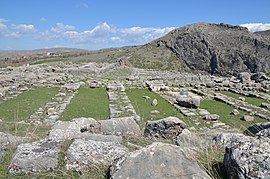 Global Information
Global InformationHittites information
Hittite Empire Ḫa-at-tu-ša / 𒄩𒀜𒌅𒊭 | |||||||||||||||||||||||||||||||||||||||||||||
|---|---|---|---|---|---|---|---|---|---|---|---|---|---|---|---|---|---|---|---|---|---|---|---|---|---|---|---|---|---|---|---|---|---|---|---|---|---|---|---|---|---|---|---|---|---|
| c. 1650 BC–c. 1180 BC | |||||||||||||||||||||||||||||||||||||||||||||
 Royal seal of the last king Šuppiluliuma II
| |||||||||||||||||||||||||||||||||||||||||||||
 Map of the Hittite Empire at its greatest extent, with Hittite rule c. 1300 BC | |||||||||||||||||||||||||||||||||||||||||||||
| Capital | Hattusa, Tarḫuntašša (under the reign of Muwatalli II) | ||||||||||||||||||||||||||||||||||||||||||||
| Common languages | Hittite, Hattic, Luwian, Akkadian | ||||||||||||||||||||||||||||||||||||||||||||
| Religion | Hittite religion | ||||||||||||||||||||||||||||||||||||||||||||
| Government | Absolute monarchy (Old Kingdom) Constitutional monarchy (Middle and New Kingdom)[1] | ||||||||||||||||||||||||||||||||||||||||||||
| King | |||||||||||||||||||||||||||||||||||||||||||||
• c. 1650 BC | Labarna I (first) | ||||||||||||||||||||||||||||||||||||||||||||
• c. 1210–1180 BC | Šuppiluliuma II (last) | ||||||||||||||||||||||||||||||||||||||||||||
| Historical era | Bronze Age | ||||||||||||||||||||||||||||||||||||||||||||
• Established | c. 1650 BC | ||||||||||||||||||||||||||||||||||||||||||||
• Disestablished | c. 1180 BC | ||||||||||||||||||||||||||||||||||||||||||||
| |||||||||||||||||||||||||||||||||||||||||||||
| Today part of | Turkey Syria Lebanon Cyprus | ||||||||||||||||||||||||||||||||||||||||||||

The Hittites (/ˈhɪtaɪts/) were an Anatolian Indo-European people who formed one of the first major civilizations of Bronze Age West Asia. Possibly originating from beyond the Black Sea,[2] they settled in modern day Turkey in the early 2nd millennium BC. The Hittites formed a series of polities in north-central Anatolia, including the kingdom of Kussara (before 1750 BC), the Kanesh or Nesha kingdom (c. 1750–1650 BC), and an empire centered on Hattusa (around 1650 BC).[3][4] Known in modern times as the Hittite Empire, it reached its height during the mid-14th century BC under Šuppiluliuma I, when it encompassed most of Anatolia and parts of the northern Levant and Upper Mesopotamia.
Between the 15th and 13th centuries BC, the Hittites were one of the dominant powers of the Near East, coming into conflict with the New Kingdom of Egypt, the Middle Assyrian Empire and the empire of Mitanni. By the 12th century BC, much of the Hittite Empire was annexed by the Middle Assyrian Empire, with the remainder sacked by Phrygian newcomers to the region. From the late 12th century BC, during the Late Bronze Age collapse, the Hittites splintered into several small independent states, some of which survived until the eighth century BC before succumbing to the Neo-Assyrian Empire; lacking a unifying continuity, their descendants scattered and ultimately merged into the modern populations of the Levant and Mesopotamia.[5]
The Hittite language—referred to by its speakers as nešili, "the language of Nesa"—was a distinct member of the Anatolian branch of the Indo-European language family; along with the closely related Luwian language, it is the oldest historically attested Indo-European language.[6] The history of the Hittite civilization is known mostly from cuneiform texts found in their former territories, and from diplomatic and commercial correspondence found in the various archives of Assyria, Babylonia, Egypt and the broader Middle East; the decipherment of these texts was a key event in the history of Indo-European studies. Cultural links to prehistoric Scandinavia have also been suggested.[7][8]
Scholars once attributed the development of iron-smelting to the Hittites, who were believed to have monopolized ironworking during the Bronze Age. This theory has been increasingly contested in the 21st century,[9] with the Late Bronze Age collapse, and subsequent Iron Age, seeing the slow, comparatively continuous spread of ironworking technology across the region. While there are some iron objects from Bronze Age Anatolia, the number is comparable to that of iron objects found in Egypt and in other places from the same period; and only a small number of these objects are weapons.[10] X-ray fluorescence spectrometry suggests "that most or all irons from the Bronze Age are derived from" meteorites.[11] The Hittite military also made successful use of chariots.[12]
Modern interest in the Hittites increased with the founding of the Republic of Turkey in 1923. The Hittites attracted the attention of Turkish archaeologists such as Halet Çambel and Tahsin Özgüç. During this period, the new field of Hittitology also influenced the naming of Turkish institutions, such as the state-owned Etibank ("Hittite bank"),[13] and the foundation of the Museum of Anatolian Civilizations in Ankara, built 200 kilometers (124 miles) west of the Hittite capital of Hattusa, which houses the world's most comprehensive exhibition of Hittite art and artifacts.
- ^ Drapkin, Israel (1989). Crime and Punishment in the Ancient World. Lexington Books. p. 29. ISBN 0-669-01279-3.
- ^ "Hittite | Definition, History, Achievements, & Facts | Britannica". www.britannica.com. 1 October 2023. Retrieved 20 October 2023.
- ^ Kloekhorst & Waal 2019.
- ^ Kloekhorst 2020.
- ^ Ancient History Encyclopedia. "Sea Peoples." September 2009. Sea Peoples Archived 18 June 2018 at the Wayback Machine
- ^ "The peaks and troughs of Hittite". 7 July 2004. Archived from the original on 3 February 2017. Retrieved 19 December 2016.
- ^ Kristiansen, Kristian; Larsson, Thomas B. (2005). The Rise of Bronze Age Society. Cambridge University Press. pp. 342–343. ISBN 9780521843638. Archived from the original on 29 March 2023. Retrieved 21 December 2021.
- ^ Kristiansen, Kristian; Larsson, Thomas B. (2005). The Rise of Bronze Age Society. Cambridge University Press. p. 249. ISBN 9780521843638. Archived from the original on 29 March 2023. Retrieved 21 December 2021.
- ^ Muhly, James D. (2003). "Metalworking/Mining in the Levant". In Richard, Suzanne (ed.). Near Eastern Archaeology. Eisenbrauns. pp. 174–183. ISBN 1-57506-083-3.
- ^ Waldbaum, Jane C. From Bronze to Iron. Gothenburg: Paul Astöms Förlag (1978): 56–58.
- ^ Jambon, Albert (24 November 2017). "Bronze Age iron: Meteoritic or not? A chemical strategy" (PDF). Journal of Archaeological Science. 88: 47–53. Bibcode:2017JArSc..88...47J. doi:10.1016/j.jas.2017.09.008. S2CID 55644155.
- ^ "Hittites". British Museum. London: Trustees of the British Museum. Archived from the original on 7 November 2014. Retrieved 7 November 2014.
- ^ Erimtan, Can. (2008). Hittites, Ottomans and Turks: Ağaoğlu Ahmed Bey and the Kemalist Construction of Turkish Nationhood in Anatolia Archived 22 September 2018 at the Wayback Machine, Anatolian Studies, 58, 141–171